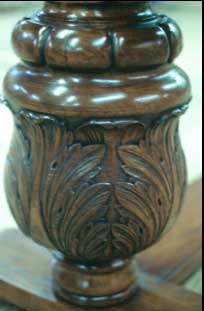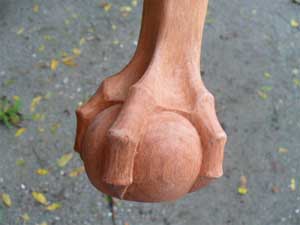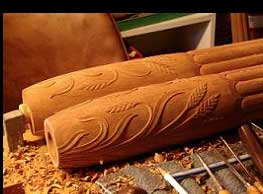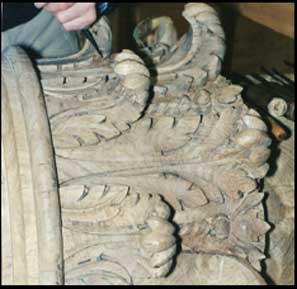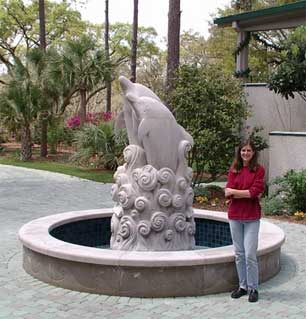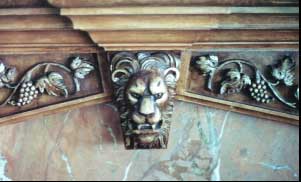
Mary May is now a woodcarver in the traditional style – something that she didn’t realize was possible when she first encountered traditional woodcarvings on a study abroad trip to Europe.
“We had the opportunity to go into castles and cathedrals, and see some wonderful, ornate carvings,” Mary said. “I was very inspired, and I thought ‘Wouldn’t it be wonderful to be able to carve like that?’ But at the time, it was only a dream; I thought it was only done 200 years ago.”
Later, however, Mary – who had worked in ceramics and been a desktop publisher – sought out master carver Konstantinos Papadakis and began to study with him. “I knew within about a month of taking classes from him that this is what I definitely wanted to do. I devoted as much time as I could to learning from him, and he took me under his wing and taught me all I knew.”
Some of Mary’s skills from desktop publishing design – a combination of drawings and technical precision, as she put it – helped her in her transfer to a woodcarving career. “I enjoyed the rules, such as ‘this is how you carve an acanthus leaf’ or ‘this is how you carve a scroll.’ I enjoyed the mathematics, and I enjoyed the precision.”
She still enjoys those aspects of her work and, she says, she likes “the challenge” that comes with carving pieces for historical reproductions “and trying to make it look as close as possible to the original piece.” For example, she might have an assignment to carve a ball and claw foot for a reproduction of a piece of furniture originally made in the 1700s. At times, when working on historical projects, Mary’s work is based off of photos – she never gets to see the original piece.
Also, unlike woodworkers who make an entire project themselves, much of Mary’s work involves providing embellishments for the work of others – whether that be furniture, fireplaces, or something else. Recently, she finished two large shell niches for the top of a built-in cabinet – a process that involved back and forth communication using drawings and photos to make sure everyone was on the same page, since the architect and his built-ins were in New York, and Mary is in South Carolina.
When she is working on something for someone else’s piece, Mary said, “a lot of times the furniture maker will actually supply me with the wood, because they have to make sure it matches the piece they’re working on.” Sometimes, that means she’s not sure of the quality of the wood she’ll be getting – she notes that mahogany’s quality has a wide range these days – or of the type of grain.
Still, Mary will do about 99 percent of her work via traditional hand carving methods, using a mallet and a chisel. “Every once in a while, I’ll use a power carver, if there’s a huge amount of wood,” she said. But more often, she’ll pick up the chisel. “I own about 175 chisels, and you can never have too many,” she said.
Mary’s favorite chisels, her “babies,” she said, are a set of antiques she picked up while in England. She also had another coup for her career as a result of that travel.
“My claim to fame is helping to carve the capitals for the reproduction of Shakespeare’s Globe Theatre in England.” She was there studying woodcarving at a London school when the opportunity arose to work on the Corinthian capitals for the two columns that flank the stage on the restored Globe.
Prior to her London trip, Mary had also studied under some Greek woodcarvers, one of whom her mentor had worked with when younger. As essentially a volunteer in a traditional workshop – which included the 2 to 4 p.m. siesta during the hottest part of the day – “I learned the Greek style of carving,” Mary said. “I also learned a lot of Greek swear words.”
That aside, much of the communication was done in sign language, but Mary said she learned “just from witnessing the people there, the fact that they worked so hard. From eight in the morning until about eight or nine at night, other than the siesta, they worked constantly and diligently. They were very particular about the quality of their work.”
Mary, who also does stone sculpture, knows about working long hours: her largest project to date was an 8-foot tall limestone fountain depicting two dolphins jumping out of the water. It was created for a family’s garden in Charleston, and “I spent a year and half chipping away at stone,” Mary said.
These days, there’s not as much call for stone sculpture – Mary estimates it at about two percent of her business – with most of her work right now being details for others’ pieces.
Also, “I’m doing a lot more teaching these days,” Mary said. As the economy slowed down, so did requests for actual woodcarving, but she’s still traveling about once a month to teach woodcarving. Many of these classes are for woodworkers involved in the Society of American Period Furniture Makers (SAPFM), who might “love to make reproductions and then get stuck at the carving,” Mary said.
“It’s just a lot of fun, because people are very interested, and excited to learn the process.”
Judging from Mary’s own history in learning about woodcarving, it’s a pretty sure bet that she knows how they feel.
